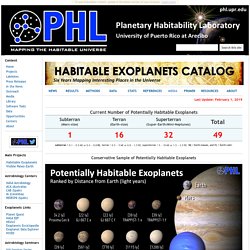

Exoplanets: Worlds Beyond Our Solar System. Exoplanets are planets outside of the solar system. They are also referred to as extrasolar planets. Starting in 1992 with the first discovery, astronomers have located about 837 such planets in 660 planetary systems around the Milky Way galaxy. Researchers believe they will find many more planets — a 2012 study estimated that each star of the 100 billion or so in the Milky Way galaxy hosts on average at least 1.6 planets. GJ1214b, shown in this artist’s view, is a super-Earth orbiting a red dwarf star 40 light-years from Earth.
New observations from the NASA/ESA Hubble Space Telescope show that it is a waterworld enshrouded by a thick, steamy atmosphere. Most of the planets astronomers have identified don’t resemble Earth. Fewer than 5 percent of known exoplanets can be seen directly with telescopes, so astronomers have come up with techniques to find them. The most common method is Doppler spectroscopy, a technique that has located around 90 percent of exoplanets.
Related: The Habitable Zone Gallery. A planet is born: Astronomers capture 'super-Jupiter' challenging ideas about the formations of new worlds. By Daily Mail Reporter Published: 21:49 GMT, 19 November 2012 | Updated: 07:55 GMT, 20 November 2012 A new planet labelled a 'super-Jupiter' has been spotted by astronomers who believe the find could challenge ideas about planet formations.

Scientists have long debated the prospect of large stars given birth to planets in a rotating disk of dust and gas but the new find suggest this could now be true. Captured by Japan's Subaru 8-metre telescope the planet, thought to be 13 times larger than our solar system's biggest planet, Jupiter, the object was spotted orbiting a star called Kappa Andromedae. Discovery: Snapped by the Subaru telescope this is the near infrared image of the Kappa Andromedae star system At more than two and a half times the mass of the sun and located 170 light-years away from Earth, the star is far from insignificant either. Although it is far from the first new planet to be discovered, it is just one of a handful that have been captured in a photograph. The Worst Places To Live In The Universe. Planets. The Habitable Exoplanets Catalog - Planetary Habitability Laboratory. The figure above shows all planets near the habitable zone (darker green shade is the conservative habitable zone and the lighter green shade is the optimistic habitable zone).

Only those planets less than 10 Earth masses or 2.5 Earth radii are labeled. The different limits of the habitable zone are described in Kopparapu et al. (2014). Size of the circles corresponds to the radius of the planets (estimated from a mass-radius relationship when not available). Larger version here. Credit: PHL @ UPR Arecibo. Location in the night sky of all the known stellar systems with potentially habitable worlds (some systems have more than one planet). The Periodic Table of Exoplanets shows all known exoplanets, including a few still unconfirmed, classified into eighteen thermal-mass categories.
PlanetQuest - The Search for Another Earth. Dark Jupiter May Haunt Edge of Solar System. A century of comet data suggests a dark, Jupiter-sized object is lurking at the solar system’s outer edge and hurling chunks of ice and dust toward Earth.

“We’ve accumulated 10 years’ more data, double the comets we viewed to test this hypothesis,” said planetary scientist John Matese of the University of Louisiana at Lafayette. “Only now should we be able to falsify or verify that you could have a Jupiter-mass object out there.” In 1999, Matese and colleague Daniel Whitmire suggested the sun has a hidden companion that boots icy bodies from the Oort Cloud, a spherical haze of comets at the solar system’s fringes, into the inner solar system where we can see them.
In a new analysis of observations dating back to 1898, Matese and Whitmire confirm their original idea: About 20 percent of the comets visible from Earth were sent by a dark, distant planet. “But we began to ask, what kind of an object could you hope to infer from the present data that we are seeing?” See Also: